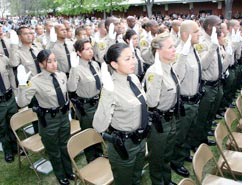Community Law Enforcement
Sheriff’s overtime practices criticized [updated]
December 20, 2009
 Los Angeles County auditors have found that hundreds of Sheriff’s Department employees are racking up such significant amounts of overtime that they may be undermining their job performance.
Los Angeles County auditors have found that hundreds of Sheriff’s Department employees are racking up such significant amounts of overtime that they may be undermining their job performance.
In a just-released report, the Auditor-Controller’s office said that 348 sheriff’s employees had worked the equivalent of an extra six months a year in overtime—substantially boosting their income while raising questions about internal controls and public safety.
“Employees who work significant amounts of overtime may not be physically/mentally capable of performing their jobs,” wrote Auditor-Controller Wendy L. Watanabe. “In addition, we noted that non-emergency overtime is not always pre-approved, and management does not always monitor individual overtime worked/reported for compliance with work schedule limitations.”
Among other things, auditors examined the top 20 overtime earners in the department, finding that the vast majority of them had violated rules prohibiting excessive double shifts or stringing together more than 12 consecutive days of work.
“Sheriff’s timekeeping staff are supposed to issue notices for work rule violations such as the ones we noted,” according to the audit report. “However, timekeepers did not identify 32 of the 44 violations noted in our testwork.”
Independently, Supervisor Zev Yaroslavsky’s office in recent months also examined the department’s top overtime earners because of the large sums being spent and concerns that deputies could be risking their effectiveness by working too many hours.
Yaroslavsky’s staff found that, in 2008, at least 10 deputies more than doubled their salaries with overtime. One deputy with a base pay of $105,561, for example, collected an additional $130,214 in overtime, bringing his annual pay to $235,775.
He was one of at least 15 deputies and sergeants who earned more than $200,000 because of overtime, according to county records.
The auditor’s overtime examination focused on the period between March 2007 and February 2008. It was undertaken as part of a broader effort by the Auditor-Controller to study payroll and personnel issues throughout the Los Angeles County bureaucracy.
As a result of its findings, the Auditor-Controller’s office called on the Sheriff’s Department to implement new overtime policies and tighter controls. Auditors began their latest report by noting that the Sheriff’s Department had exceeded its overtime budget by an average of 104% during the past five fiscal years—or an average of nearly $83 million annually.
Sheriff’s officials, responding to the findings, noted that overtime for fiscal year 2008-2009 was dramatically reduced as department vacancies were filled, meaning fewer overtime hours were needed to backfill by existing personnel.
In its response, which is attached to the audit, the department also said some of the officers cited for working multiple double shifts and excessive consecutive days were assigned to Special Enforcement Bureau, Narcotics and Homicide, where they “are sometimes required to respond to unplanned and/or critical events…While the units make every attempt to schedule their personnel in order to avoid such violations, in the interest of public safety, it is sometimes unavoidable.”
Besides the sheriff’s use of overtime, the Auditor-Controller also examined other financial issues within the department, including industrial accident payments, leave accounting, monitoring of bonus eligibility, processing employee terminations and data security. In these areas, too, auditors found problems.
For example, the auditors reviewed the cases of 25 employees who were on extended sick leave and found that eight, or 32%, were potentially “overpaid” $7,000 apiece because of a lack of rigorous oversight of documents that were being filed. Auditors found similar overpayments in a review of industrial accident cases.
[Updated 12/22]
The Board of Supervisors today unanimously approved a motion by Supervisors Zev Yaroslavsky and Gloria Molina that would bring more oversight and accountability to overtime usage in the Sheriff’s Department.
Among other things, the motion directs the Chief Executive Officer to report back to the board on January 19 with strategies for identifying and implementing new overtime policies and controls.
In one of the most significant reforms, the motion directs the CEO, with help from the Auditor-Controller, to monitor Sheriff’s employees whose overtime earnings exceed 50 percent of their regular salaries. The goal for such reviews is to identify the kind of work schedule violations that were uncovered by auditors and that raise questions about whether job performance is being risked by excessive overtime.
Innovative probation/police teams cut valley gang crime
November 2, 2009
 The LAPD and the county’s Probation Department joined forces for the first time more than two years ago to battle the San Fernando Valley’s rising tide of gang violence. The idea: to embed a deputy probation officer in LAPD gang details in six Valley stations to provide a missing dimension to gang enforcement.
The LAPD and the county’s Probation Department joined forces for the first time more than two years ago to battle the San Fernando Valley’s rising tide of gang violence. The idea: to embed a deputy probation officer in LAPD gang details in six Valley stations to provide a missing dimension to gang enforcement.
The result, according to police and probation officials, has been a significant drop in gang-related violence in the Valley since the Community Impact Teams hit the streets. Valley gang crime has fallen 18 of the 28 months the program has been in existence – including ten of the latest 12 months, ending in June, 2009, for which statistics are available. “It’s clearly trended down and CIT has been a part of that,” says Paul Vinetz, Probation Director for the Third District, who helped design the program.
As members of Community Impact Teams, six deputy probation officers roll with LAPD Valley gang officers to answer emergency calls as well as make proactive community police stops. They focus on assessment and case management of high-risk gang-involved offenders in crowded neighborhoods. The probation officers have conducted thousands of face-to-face contacts, home visits and searches that have yielded hauls of firearms and other weapons. In 2009, CIT officers seized 35 firearms through August, including one June incident that yielded a sawed-off shotgun and two assault weapons.
Teaming up with Probation officers give LAPD gang cops a greater ability to identify probationers quickly and make warrantless “probation searches” of cars or homes that can turn up drugs or weapons. Being out with the LAPD officers gives the Probation Department greater street presence to spot problems with individual probationers. Working in dense neighborhoods with significant gang problems, probation officers say that their skills and sensitivity have helped them to flag hot spots and act on crime trends that might be invisible to traditional law enforcement alone. “We bring a different focus that complements what the LAPD officers do,” says Probation Director Jose Jimenez, who heads the Intensive Gang Supervision Program that includes the CIT.
Beyond crime suppression efforts, the embedded probation officers also provide another set of eyes and ears on the alert for youngsters at-risk from exposure to gangs and drugs. Probation officials say officers can then make more timely and effective referrals to the Department of Children and Family Services’ child abuse hotline. They can also refer probations and families to other services, including mental health, education, drug treatment and domestic violence.
Sex bias finally arrested in the Sheriff’s Department?
October 30, 2009
 None of the young women who graduated this fall from the sheriff’s academy have met the grandmother who fought their battles, who paved the way for them to comprise 40 percent of their class for the first time in department history.
None of the young women who graduated this fall from the sheriff’s academy have met the grandmother who fought their battles, who paved the way for them to comprise 40 percent of their class for the first time in department history.
If they’ve heard of Susan Bouman at all, it’s only as the name on an aging court case.
Back in 1980, Deputy Bouman filed a federal class-action lawsuit alleging gender discrimination after she was denied a promotion to sergeant. She won the case in 1988 and received $31,500 in back pay, plus benefits.
More important, the case led to a federally-mandated agreement—a consent decree—compelling the department to hire and promote more women and establish a state of the art anti-harassment policy. That victory was much longer in the making.
This fall, nearly two decades after Bouman’s retirement, a federal district court judge quietly lifted a major portion of the consent decree, verifying that the department has successfully put policies in place to effectively guard against sexual harassment. The so-called “equity” portion of the consent decree was the second major victory, following the creation of a gender-neutral sergeant’s exam that won court approval in 2007.
The anti-harassment victory was bittersweet for the 61-year-old former sheriff’s deputy, now known as Susan Paolino. She recalls the years of appeals and foot-dragging that preceded the strides of more recent times. “I think that they’ve made a lot of progress,” says Paolino, who retired as a sergeant in 1990 with a stress disability she attributes to years of fighting the department. “But I’m sorry it’s taken so long.”
Undersheriff Larry Waldie, who oversees compliance with the so-called Bouman decree, points proudly to the department’s harassment policy “as a model for other departments.” But he acknowledges that, for years, the department “chose to take everything to court” rather than resolve the harassment and promotion problems.
“Quite frankly,” he says, “our old way was not the right way.”
A consent decree is a voluntary but binding pact supervised by a judge, with the defendant and plaintiff agreeing to a series of remedies to correct the contested behavior. In some cases—such as the federal consent decree recently lifted at the LAPD–courts appoint third-party monitors. In this case, the judge ordered the two sides to work matters out between themselves, with the judge as the final arbiter. In all consent decrees, judges can impose sanctions, including fines.
“Everybody asks what’s taken so long,” says Paolino’s attorney, Dennis Harley. The answer, he says, is simple: In the early years of the case, sheriffs Peter Pitchess and Sherman Block “didn’t want anyone telling them what to do.”
Today, women make up nearly 17 percent of the sheriff’s sworn personnel, slightly less than the percentage of women in the LAPD. Paolino credits Sheriff Lee Baca, who assumed office in 1998, for more rapidly upending the old-boy culture.
“When he came in,” Paolino says, “the department began an effort to comply with the consent decree. Before that, they fought it tooth and nail.”
Observers and attorneys familiar with the case agree. “It was a priority for Sheriff Baca to resolve the issues under the consent decree to move the department forward,” says Abby Liebman, founder of the California Women’s Law Center and a former member of the Equity Oversight Panel, created by County Supervisors in 2002 to monitor harassment incidents and recommend discipline within the department.
In the mid-1970s, Paolino, then known as Bouman, was a young deputy who couldn’t win promotion to sergeant, despite scoring well on the exam. Harassment and discrimination were pervasive, she says, a part of the culture. Male colleagues left pornographic pictures lying around and flooded her mailbox with transfer request forms so she’d get the hint and leave.
After her internal appeals failed, she filed her lawsuit. By the time she won, she’d been promoted to sergeant, but male colleagues still behaved badly. “There was more harassment after I was sergeant than before,” she says.
The department, meanwhile, fought the judgment at the Ninth Circuit and the U.S. Supreme Court without success, before entering into the consent decree in 1993.
By then, Paolino had retired and started law school. She practiced gender-discrimination law in Whittier and, among her cases, successfully sued Los Angeles County on behalf of female lifeguards who’d been harassed by their male colleagues. Retiring from the law earlier this decade, she moved to San Diego County to help raise a grandchild.
Paolino says she doesn’t hear from women at the Sheriff’s Department but regards herself as a pioneer, saying her suit has “made a big difference” in the department’s gender policies and practices.
Still, two hurdles remain before the consent decree can be vacated entirely.
One concerns ending gender bias in the hiring of entry-level deputies. To increase numbers, the department is aiming at a goal of averaging 20.11 percent women for each graduating class. The department has reached that number in every class since July 2008, with two most recent graduations this fall hitting the 40 percent mark. The department also is revising the physical fitness and firearms tests to level the playing field for women.
“They seem to be working hard to get females through the academy now,” Paolino says.
The other remaining hurdle involves the hiring of women into 51 “coveted positions,” key deputy positions that can serve as stepping stones for eventual promotion to sergeant. To be certain that the job requirements don’t favor men, the department has hired outside experts to “validate” new tests for each position. Only one of the jobs has been validated so far, with a second following in a few weeks. Attorneys on both sides expect the pace to accelerate markedly next year.
In the meantime, the department’s interim goal is to have the percentage of women in those coveted positions be proportional to their overall representation in the department—currently, a lag of about two percentage points that sheriff’s officials hope to fix next year, says Capt. Larry Brogan of the Sheriff’s Labor Relations and Compliance section.
If the department remains on track, the decree could be lifted by mid 2012. For her part, Paolino is optimistic but retains the wary perspective of a battle-scarred veteran.
“I’ve got a 30 year history with this,” she says. “I was seen inside the department as a three-headed monster.”











 405 bridge work causes a stink
405 bridge work causes a stink
